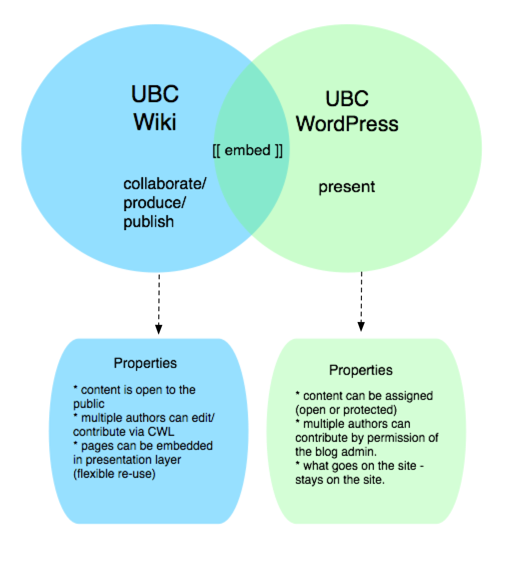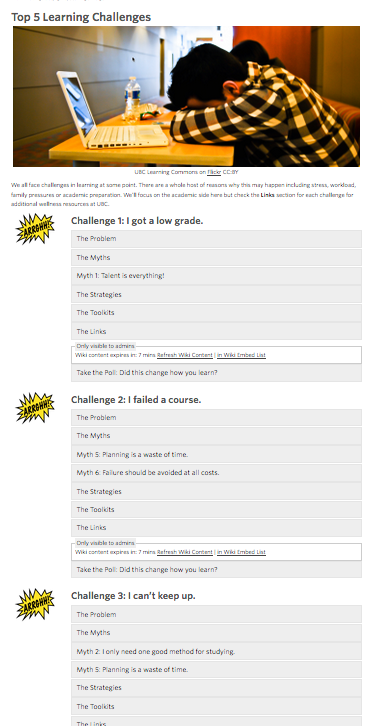Documentation:CTLT Resources/TLPD/Working Guidelines for Resource Development on UBC Wiki/Rationale

The Teaching and Learning Professional Development (TLPD) team at the Centre for Teaching, Learning and Technology (CTLT) at UBC offers consultation and other services and programs related to the development of effective teaching practices at UBC. As part of our work, we often develop resources on topics of interest to faculty and students (ie course design, class climate, inclusion & diversity, DIY media, open education, learning principles, etc.) Often we intend for these resources to be shared among our staff and beyond - with the UBC community and the public. Developing and sharing resources online, involves a set of considerations like:
- who will use the resource I create and how might it be helpful?
- who am I collaborating with to develop the resource?
- what approach will we use to collaboratively write and review a resource (if you are collaborating)?
- where will I publish the resource? or how will people find it?
- what are the most promising technologies to help me do what I intend to do?
The challenge
We are lacking a cohesive, cross team strategy for the development, maintenance and curation of the resources we create as a team and with colleagues outside CTLT. This means that we can't easily find the resources that have been created on the wiki or elsewhere and we can't easily curate them into companion resource lists for our resource sites (ie Teaching Pathways), nor can we easily access resources from colleagues that may be useful during a consultation.
Recent feedback from the TLPD team reinforces the idea that, while the wiki may be a good choice for collaborative authoring and creating content, it is not currently functional as a searchable resource for faculty or others unfamiliar with its' contents. However, the power of the wiki is in its ability to support collaborative resource development, version control and curation. In order to draw on the extensive collection of resources that currently exist and add to resources in a way that supports "findability" at least among our staff, we need to:
- curate content into collections: collections and categories can be determined by the curator to meet specific needs.
- ensure resources can stand on their own and are useful as guides (templates my be helpful here)
- publish the resources where faculty (and others) are likely to find them.
TLPD resource repository
If we agree that we need a repository for our shareable resources, then it's helpful to identify a set of requirements related to the development and distribution of our resources. This is a beginning list that can be added to:
- allows for collaborative writing/editing within the UBC community.
- allows for discussion related to content and re-use.
- supports curation (categories, table of contents, templates, etc.)
- can easily be formatted with a presentation layer (via embed)
- allows for long-term centralized archiving of resources for future reuse or revisions
From your perspective, what additional requirements should a resource repository meet - in order to meet your needs as resource authors and contributors?
Proposed strategy
The UBC Wiki provides an open, public facing, CWL protected collaborative editing environment that meets the needs for curation and comment/discussion as discussed above, while supporting open sharing and collaboration among the UBC community. Much development work has been undertaken in past years to develop approaches and shortcuts (ie. wiki embed) to allow for wiki content to be seamlessly added to WordPress sites - in order to provide the desired presentation layer - when required and also to allow the content to be authored and edited in one place and published on multiple sites. The UBC Wiki and our installation of WordPress works together via the embed code. The means your content can live in the space that is more flexible and accessible for editing (the UBC Wiki) but can be published on a WordPress site (where you can apply strategies through the wiki embed to improve usability (ie accordians to minimize content overload).

When comparing the two platforms (UBC Wiki and WordPress), you might think of it this way: the wiki offers more flexibility on terms of content authoring and re-use and WordPress offers more control in terms of authoring and permissions.
Example in practice
In the example below, the Myths About Learning page was created in the wiki for the Learning Commons. Each of the myths were created in a separate page and brought together in one through embedded links (transclusion). This allowed for maximum flexibility in terms of content re-use. Once we took it into the Learning Commons, the myths were embedded in a single page - see Myths About Learning on the left side below. But we also wanted the myths as individual pages to be embedded in another resource with a focus on Learning Challenges on the right side below. So we authored the content once in the wiki and published it 3 ways.

 |
 |
Questions for reflection
- How would you design a resource for maximum sustainability (in terms of updates, management and curation)?
- Where are there opportunities in the work that you do for sharing your resources more broadly?
- What makes for an effective online resource in your opinion?
Please share any reflections that you don't mind making public, on the discussion page associated with this wiki. You'll need to log in with your CWL in order to do so.
Support
Our open learning resource "group" can help you in the process of resource development and publication (via WordPress). Contact cindy.underhill@ubc.ca; will.engle@ubc.ca; rie.namba@ubc.ca or deborah.chen@ubc.ca; emily.renoe@ubc.ca